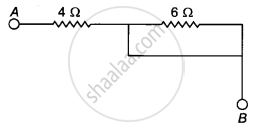Advertisements
Advertisements
प्रश्न
Two conducting wires of the same material and of equal lengths and equal diameters are first connected in series and then parallel in a circuit across the same potential difference. The ratio of heat produced in series and parallel combinations would be:
विकल्प
1 : 2
2 : 1
1 : 4
4 : 1
उत्तर
1 : 4
Explanation:
Since both the wires are made of the same material and have equal lengths and equal diameters, they have the same resistance. Let it be R.
When Connected in series, their equivalent resistance is given by
Rs = R + R =2R
When connected in parallel, their equivalent resistance is given by
`1/("R"_p) = 1/"R" + 1/"R"`
= `2/"R"` or `"R"_p = "R"/2`
Further, electrical power is given by,
`"p" = ("V"^2)/"R"`
Power or heat produced in series, `"p"_s = ("V"^2)/("R"_s)`
Power or heat produced in parallel, `"p"_p = ("V"^2)/("R"_p)`
Thus, `("p"_s)/("p"_p) = (("V"^2)/("R"_s))/(("V"^2)/("R"_p))`
= `("R"_p)/("R"_s)`
= `("R"/2)/(2"R")`
= `1/4`
or Ps : Pp = 1 : 4
APPEARS IN
संबंधित प्रश्न
Why are copper and aluminium wires usually employed for electricity transmission?
Why are alloys commonly used in electrical heating devices? Give reason.
Which of the following are conductors and which are insulators?
Sulphur, Silver, Copper, Cotton, Aluminium, Air, Nichrome, Graphite, Paper, porcelain, Mercury, Mica, Bakelite, Polythene, Manganin.
What is the general name of the substances having infinitely high electrical resistance?
Distinguish between good conductors, resistors and insulators. Name two good conductors, two resistance and two insulators.
What happens to the resistance as the conductor is made thinner?
What happens to the resistance as the conductor is made thicker?
A wire is 1.0 m long, 0.2 mm in diameter and has a resistance of 10 Ω. Calculate the resistivity of its material?
Give two examples of substances which are good conductors of electricity. Why do you think they are good conductors of electricity?
How does the resistance of a conductor depend on:
length of the conductor?
How does the resistance of a conductor depend on:
area of cross-section of the conductor?
How does the resistance of a conductor depend on:
temperature of the conductor?
What would be the effect on the resistance of a metal wire of:
increasing its length?
Write the relation between resistance and electrical resistivity of the material of a conductor in the shape of a cylinder of length `'l'` and area of cross-section `'A'` . Hence derive the S.I. unit of electrical resistivity.
The effective resistance between A and B is:

A cylindrical conductor of length l and uniform area of cross-section A has resistance R. Another conductor of length 2l and resistance R of the same material has an area of cross-section:
